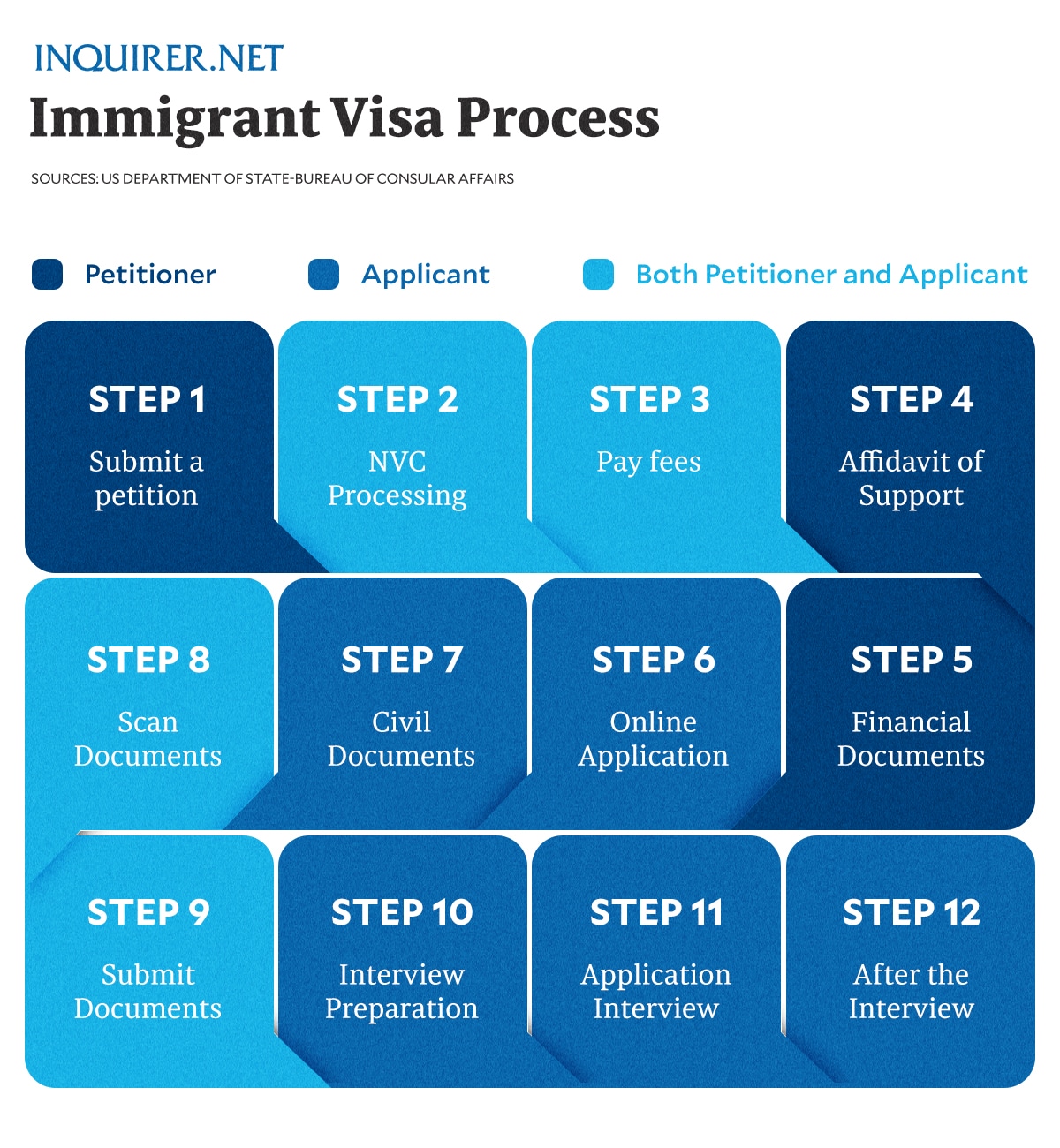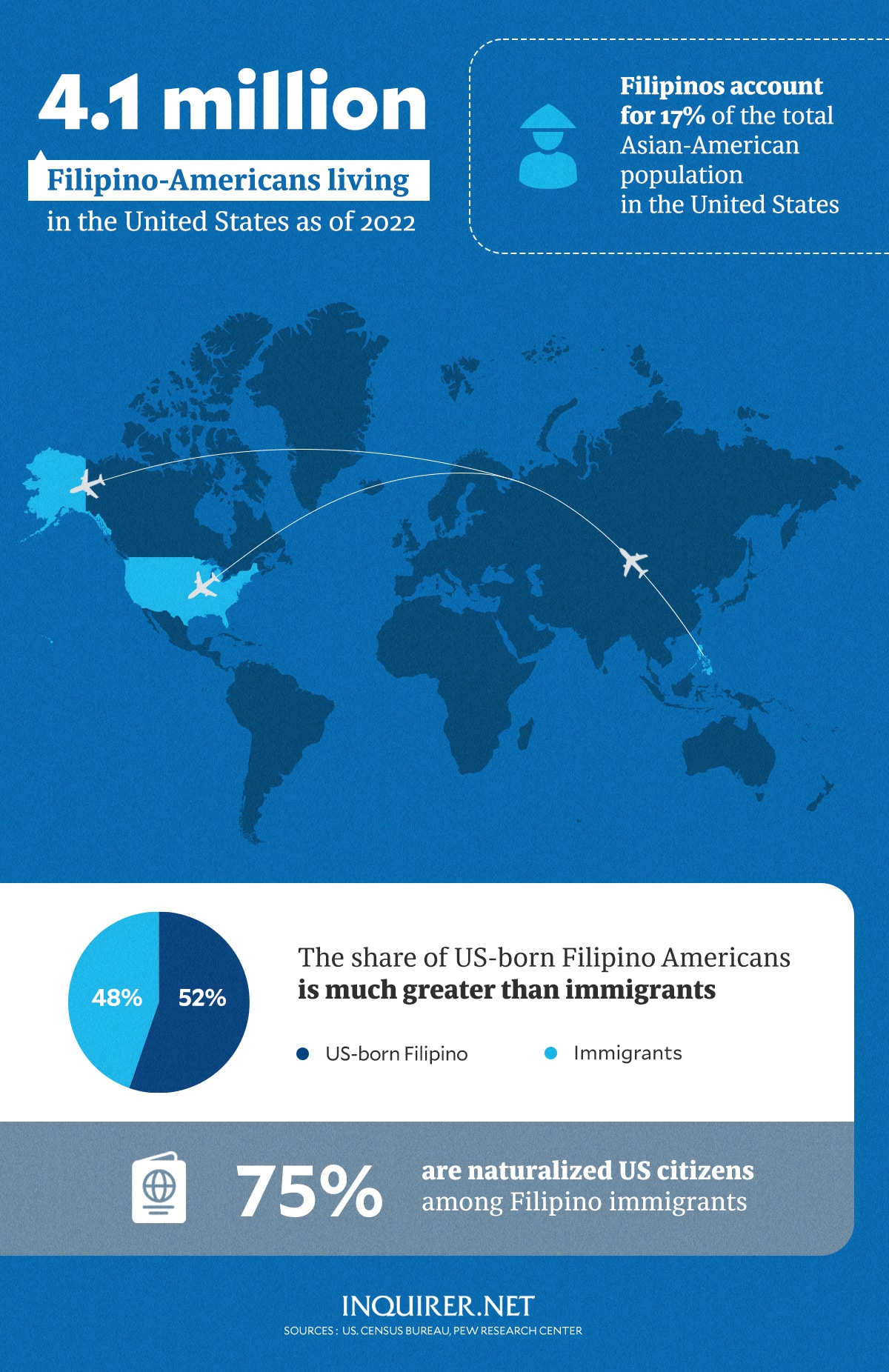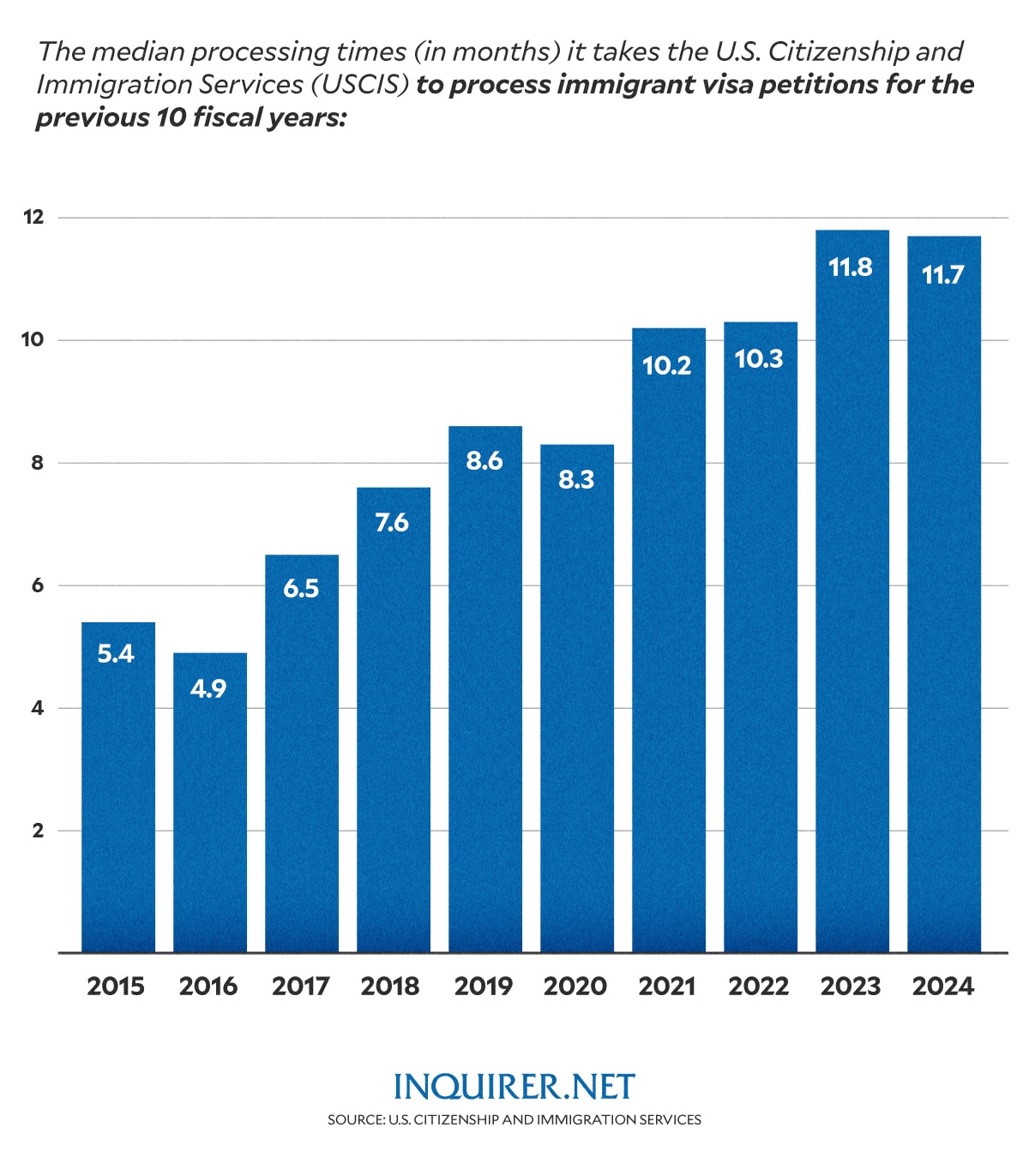MANILA, Philippines—As Election Day descends in the United States, millions of Filipino families are watching closely, with many concerned about how a potential Donald Trump victory might impact their hopes of reuniting with loved ones still in the Philippines.
During his campaign, Trump has doubled down on promises to reform immigration, a key part of his “America First” agenda. His platform echoed the strict immigration policies he pursued during his first term, which aimed to curb both illegal and legal immigration.
One topic that frequently arises in discussions about Trump’s hardline stance on immigration—ranging from his first term to his current bid for a new one—is his plans to curb a practice known as “chain migration.”
The term chain migration, which loosely refers to legal immigration based on family ties to a US citizen or permanent resident, has been deemed a racist slur by some critics in light of Trump’s repeated attacks on it.
It simply refers to family-based immigration, which has become the most common method for obtaining green cards in recent years. This system allows immediate relatives — spouses, parents, and unmarried children under 21 — to bypass annual quotas, meaning there is no limit on the number of green cards issued for these family members each year.
According to The Washington Post, restrictionists — those advocating significant cuts to legal immigration, including the elimination of family-based immigration categories — have “hijacked and weaponized” the term by framing it using language intended to evoke fears of undesirable individuals overwhelming America’s borders, straining welfare systems, and depleting resources.
For many immigrants, the term encompasses more than just the process of sponsoring family members to join them in their new country. It represents a vital means of family reunification and the preservation of cultural ties, which is particularly significant for many Filipino immigrants in the US.
While the outcome of the presidential elections remains uncertain, many immigrants are left wondering what the future holds for their hopes of family reunification should Trump win and serve another term.
‘Ending’ chain migration
Trump’s bleak outlook on immigration, which critics argue stems from a skewed view of racial purity, has been a cornerstone of his political messaging since he first entered the presidential race in 2015.
Should he return to power, Trump plans to initiate what he refers to as the “biggest domestic deportation operation in US history.”
This proposal, aimed at millions of undocumented individuals and fundamentally changing America’s approach to newcomers, is anticipated to include extensive workplace raids and potentially utilizing military assets. At the same time, government funding will go towards enlarging the barrier along the Mexico border.
“Based on a detailed playbook the far-right published last year, the reality of what could emerge is even more clever and destructive than previously imagined,” warned the Niskanen Center, a US-based nonpartisan think tank, referencing the Mandate for Leadership, a 920-page policy blueprint published by the conservative The Heritage Foundation as part of Project 2025.
“The 920-page tome — a blueprint for a second Trump administration across all policy areas — spells out precisely how a new Trump administration will dismantle the US immigration system and how those policy changes will impact jobs, housing, education, transportation, and commerce for both immigrants and Americans,” it added.
In addition to mass deportations, a renewed Trump administration would likely prioritize pushing Congress to reduce or even eliminate family-based immigration.
The latest iteration of the Mandate envisions restructuring US immigration by ending family-based immigration, often labeled “chain migration,” and transitioning to a merit-based system aimed at admitting highly skilled individuals.
“The incoming Administration should spearhead an immigration legislative agenda focused on creating a merit-based immigration system that rewards high-skilled aliens instead of the current system that favors extended family-based and luck-of-the-draw immigration,” the Mandate stated.
“To that end, the diversity visa lottery should be repealed, chain migration should be ended while focusing on the nuclear family, and the existing employment visa program should be replaced with a system to award visas only to the ‘best and brightest’,” it added.
This means that if someone wants to move to the US, their chances would depend more on their job skills and less on having family members already living there.
Similarly, those relying on the diversity visa lottery to enter the country will no longer have that option available. Currently, this lottery provides a random chance for people from countries that have low rates of immigration to the US to gain a visa.
How will this impact Filipinos?
For Filipino Americans, particularly those hoping to reunite with parents and siblings, Trump’s proposed policies could have a significant impact.
READ: Fil-Ams target of information manipulation in US polls
In 2022, the Philippines ranked as one of the leading countries of origin for immigrants to the United States, representing a notable four percent of the total immigrant population. That same year, the US Census Bureau reported approximately 4.1 million Filipino Americans residing in the US.
Moreover, research from the Pew Research Center indicates that Filipinos constitute 17 percent of the Asian American population, emphasizing the potential impact of Trump’s immigration policies on Filipino families seeking reunification.
For many Filipino Americans, the family-based immigration system serves as a vital avenue for bringing their loved ones to the US. The system has been a lifeline, allowing them to support aging parents, care for siblings, or provide opportunities for their children.
One of these individuals is 26-year-old Lyn Rodriguez, who is currently petitioning for her 48-year-old mother, Maria.
“Para magkasama-sama na ulit kaming family and makapag-start nang mas maayos na life dito. Hoping na mas maayos life dito dahil okay rin ang benefits,” Lyn said when asked why she decided to petition her mother.
(To be together as a family again and to start a better life here. I’m hoping for an improved life here because the benefits are good as well.)
Lyn understands the challenging process of bringing a family member to the US having gone through it herself since 2015. However, as a student at the time, she had to travel from the Philippines to the US every summer.
After graduating from college, she was finally able to settle in the US permanently, officially becoming a US citizen in 2018.
Now, she worries that if Trump wins the election, his stringent immigration policies could jeopardize her ongoing petition to bring Maria to the US.
“Nag-alala ako siyempre since ongoing pa petition ko para sa Mama ko and gusto ko na talaga siya makapunta dito. May balak pa naman kami i-petition‘yung half brother ko and dad niya,” she told INQUIRER.net.
(I was worried, of course, since my petition for my mom is still ongoing, and I really want her to come here. We also plan to petition my half-brother and his dad.)
Delayed family reunification
Data show that the median processing time for immigrant visa petitions handled by US Citizenship and Immigration Services (USCIS) over the past 10 fiscal years has steadily increased, peaking in 2024 to a minimum of 12 months.
“With more demanding requirements and an increasingly complex form, USCIS is struggling to keep [Form] I-130 (Petition for Alien Relative) processing times within their desired range,” explained immigration services company CitizenPath.
According to USCIS, about 80 percent of I-130 petitions submitted to their service centers are processed within 15.5 months. Additional data show that most I-130 petitions are either approved or denied within a timeframe of 10 to 24 months — or even longer — from the filing date.
However, immigrants from countries with high numbers of applicants, like the Philippines, often face years-long waits to receive a green card. This is because no single country can account for more than seven percent of all green cards issued each year.
In Lyn’s case, the process of petitioning to bring Maria to the US began two years ago, in 2022. Maria has already completed her interview at the US embassy, and they are now waiting for the results of her medical exam to determine if she’s approved to enter the US.
“The process takes a long time, with a minimum wait of one year to move from one stage to the next,” said Lyn.
Experts warn that Trump’s immigration policy, which restricts family-based immigration, could result in longer wait times for US citizens and permanent residents seeking to bring their family members to the US.
“Legal immigration could also take a hit as Trump […] has made it clear that he wants stricter visa policies for both family reunification and employment-based immigration,” immigration attorney Abhisha Parikh told Business Standard.
A 2018 Reuters report noted: “The intensified focus on chain migration has been accompanied by an overall slowdown in adjudications of family-based visas.”
Data show that over the past decade, the number of I-130 cases in backlog has reached unprecedented levels. If USCIS does not address this issue, the growing backlog will further lead to even longer processing times for future petitioners.
Filing petitions
During the interview, Lyn recalled feeling extremely cautious as she submitted each form.
“Nakakakaba mag-submit ng forms para sa petition dahil nakakailang checkako bago mag-submit. Marami kasi kaming nababasa na hindi nagpu-push thru agad petition dahil may error sa forms na sinubmit,” said Lyn.
(It’s nerve-wracking to submit the forms for the petition. I double-checked them so many times before sending them. We’ve read a lot about petitions not going through right away because of errors in the submitted forms.)
Historical data from the USCIS showed that by the end of fiscal year 2023, the agency received a total of 924,202 I-130 petitions. Approximately 11 percent of these petitions were rejected due to incorrect filing.
US citizens can petition for their spouse, unmarried children under 21, married children over 21, parents, and siblings (if the petitioner is 21 or older). Additionally, they can petition for a fiancé residing outside the US and the fiancé’s children under 21.
To sponsor a family member for immigration to the US, US citizens must file Form I-130, Petition for Alien Relative, to establish a qualifying relationship and reserve an immigrant visa (green card) for the relative.
According to USCIS, submitting Form I-130 is the first step in helping an eligible relative immigrate to the US and apply for a green card. However, it is important to note that the filing or approval of this petition does not grant any immigration status or benefits to the relative at this stage.
The US Department of State – Bureau of Consular Affairs outlines the complete immigrant visa process in the following steps:
- Submit a Petition
- National Visa Center (NVC) Processing
- Pay Fees
- Affidavit of Support
- Submit Financial Documents
- Complete Online Application
- Provide Civil Documents
- Scan and Upload Documents
- Submit Documents to NVC
- Prepare for the Interview
- Attend the Applicant Interview
- Post-Interview Processing
Hoping for the best
Approximately two-thirds of the over one million individuals granted green cards each year do so through family-based immigration. In 2018, the Pew Research Center predicted that under Trump’s proposed chain migration restrictions, this figure could decrease to around one-third.
“Hoping na hindi matamaan case ng mom ko dahil nasa last stage na kami (I’m hoping that my mom’s case won’t be affected because we’re already at the last stage),” Lyn said.
As the U.S. presidential election approaches, just hours away with the election scheduled for November 5, 2024, many immigration policies and potential changes remain uncertain.
READ: LIVE UPDATES: 2024 US presidential
If Trump were to win a second term, it is likely that his administration would revive stricter immigration policies, potentially impacting the processing times and approval rates for family-based immigration petitions.
Given the significant backlog in applications and the growing uncertainty surrounding future immigration reforms, many applicants like Lyn are anxious about the potential delays and additional challenges that may arise in the coming years.
READ: How immigrants who just became US citizens plan to vote in the 2024 election
“Kinakabahan lang ako sa future petitions dahil tatagal [‘yung process] kung si Trump talaga (I’m just nervous about future petitions because the process will take longer if it’s really Trump),” said Lyn.
Related stories:
Harris or Trump win won’t affect PH-US defense ties
What if the US election ends in a Trump-Harris tie?
Highly-educated Filipinos as OFWs: A double-edged sword for PH







